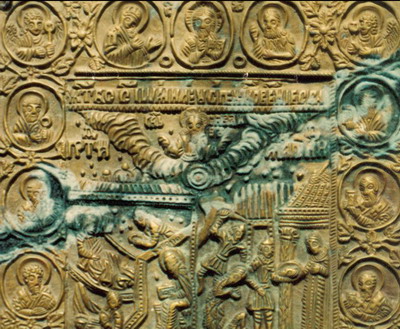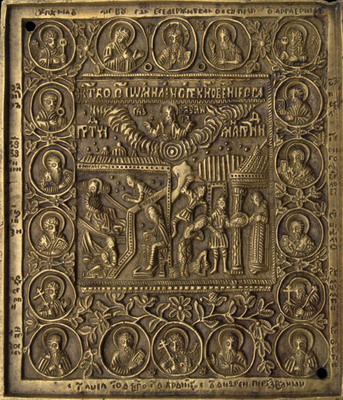Creation of the scientific and restoration department of the National Art Museum of the Republics of Belarus is directly connected with formation of its collection.
As a result of the conducted scientific studies it was revealled the degree of safety, authenticity and presence records of the gained works of art.
Restoration works from 1957 were executed by the artists-restorers of the restoration workshop of the museum - B. Dmitriyev, N. Kuychik, V. Horoneko, S. Stepanenko.
Especially complex restoration works were conducted by the restorers from Leningrad and Moscow. At the period 1952, 1954 till 1975 it was restored and revealled from the late records great amount of works of the ancient Belarusian painting.
Quite often restoration works were executed by the Russian restorers in Minsk, in the museum that enabled the museum restorers to observe directly and be trained profession of the restorer.
The main volume restoration works of the ancient Belarusian полихромной sculpture and painting is executed by the restorers of high category A. Shpunt and P. Jourbei. Technological particularities, characteristic to the works of the ancient Belarusian art, often require exceptional methods and approach in choice of the material and ways of restoration. It promoted shaping of the national school of restoration.
Scientific and restoration department was created in 1989. Its first leader was N. Vedenev, restorer of the easel oil and tempera painting.
Since 1996 scientific and restoration department was headed by T. Gorovets. Since 2008 scientific and restoration department was headed by A. Shpunt.
Today 18 specialists work in the department, who have highest, the first and the second categories of the artist-restorer on restoration of the easel oil and tempera painting, полихрмной sculpture, works of art from textile, porcelain, skin, frames, works of graphic art. They were trained at the restoration centres of Leningrad, Moscow and in Poland.
Scientific employees of the department conduct technical and technological and x-ray studies of works of painting.
They participate in expert examination and attribution of the works of art, in joint project by introduction of the new technologies in preservation and restoration processes.
As a result of joint activity with the Institute of Physics named after B. Stepanov of the National Academy of Sciences of Belarus it became possible creation installation and development methods of clearing bronze and other metals works of art by method of laser peeling.
Materials of the studies and inventions, made by the employees of the scientific and restoration department, are published in the collections of conferences on restorations and in the Messages of the National Art Museum of the Republics of Belarus.
Restoration:
Icon "Nativity of the Virgin", 18 c.
Wood, levkas, tempera, carving
139х104
Restorer - A. Shpunt

At arrival of the icon for restoration painting was found under the layer of preventive stickers, darken varnish and contamination. Multiple losses of the author's painting.
The presented icon was nearly lost work of art.

In the process of the fortification of painting, removing of the contamination and darken varnish, making of restoration priming, execution of toning and fixing of the varnish it was possible to restore if not painting, but at least the author's idea.
Cristmas of Ioann the Forerunner with Cutting of the Head
Bronze, casting, relief
14,2х12,4
Restorer - T. Gorovets

The picture has come to restoration with general contamination. In the higher part of the icon horizontally- traces of the passing corrosion processes of bronze.
For their removing it was used laser clearing.

Laser radiation was directed on the formed corrosion layers, which was absorbed by the products of corrosion and they, warming, were vaporized. The surface was refined, and noble patina was preserved.
